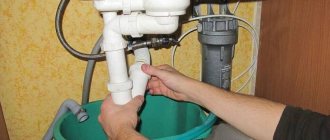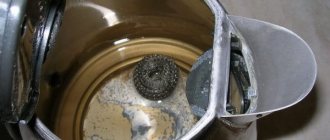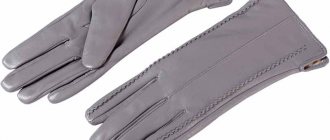A clogged kitchen sink is a situation that almost everyone faces.
In this case, the water either does not drain at all or leaves very slowly. In most cases, you can correct the situation on your own, using mechanical cleaning methods, special chemicals and even folk recipes.
In this article you will learn how to quickly and effectively clear a clogged kitchen sink at home.
Reasons for appearance
Before cleaning the drain, it is recommended to determine the cause of the blockage. The main ones include the following:
- Incorrect installation of plumbing. This could be, for example, installing waste pipes at the wrong angle.
- Foreign objects entering the drain that block and clog the pipe.
- Gradual accumulation of fat and other deposits in the pipes.
In cases where improper installation occurs, simply cleaning the pipes is not enough.
Procedure for using cleaning products
When using directed action agents against blockages in pipes, you must adhere to the following sequence:
- Pour or pour the product into the neck of the sink.
- Following the instructions in the instructions, wait the required time and flush the pipes with water.
- To more accurately determine the required volume, use measuring cups.
Tip: when using powders or granules, the drainage area must first be cleared of water and dried. Otherwise, the chemical reaction will start earlier. These products are also actively used for the subsequent prevention of blockages.
How to clean mechanically?
Mechanical cleaning methods are often used to remove blockages . These include the use of a glass, a plunger or a special cable.
Plumbing cable
The cleaning cable is often metal. It has a handle on one side and a split, hard end for cleaning on the other.
Application:
- The working part is lowered into the drain.
- By turning the handle, the cable is moved along the drain pipe.
- After removing the cable from the drain, there may be debris at the end of the cable that is obstructing the passage of water.
- Repeat the procedure several times.
- Check the quality of cleaning by pouring water into the sink.
- If necessary, I repeat the processing.
Mechanical cleaning can be supplemented by using special chemicals or home recipes.
You can watch how to work with the cable in the following video:
Cup
For small blockages, when water passes through, but not as quickly as usual, even an ordinary glass can help.
Principle of operation:
- take some water into the sink;
- lower the glass so that it covers the drain hole;
- press and then sharply move your hand with the glass up;
- repeat several times.
Cleaning using this method is similar to the principle of using a plunger, but it will not help deal with serious blockages.
plunger
It is advisable to have a plunger in the household - a simple tool that will help deal with fresh blockages.
Procedure:
- fill the sink with some water;
- install the plunger so that the drain is completely covered with the working nozzle;
- press the plunger with force and pull it sharply towards you;
- repeat the treatment several times in a row, even if the plug has already been removed.
In addition to the usual plunger, you can use pneumatic models.
Cleaning the sink using mechanical methods
Not everyone understands what to do if the kitchen sink is clogged. There are more than 20 different methods for resolving the issue. To remove blockages, mechanical devices are used to clear the pipeline.
plunger
A plunger is a tool for cleaning a sink drain, consisting of a plastic or wooden handle and a rubber corrugated cap. Its operating principle is similar to that of a back pressure pump. When performing upward and downward movements, the debris accumulated in the siphon area rises upward.
How to clear a blockage at home:
- to create hydraulic pressure, the overflow holes in the sink are closed with plugs;
- the plunger is pressed against the drain hole;
- fill the sink with water;
- make rhythmic forward movements.
When the handle is lifted, the water moves behind the cap, which rises upward. When you press on the plunger, it moves upward by inertia, so part of it spills out from under the edges of the plunger. As a result, water along with dirt is pumped out of the clogged pipe.
If, after using the plunger, water easily flows into the pipeline, this indicates that the blockage has been removed. To speed up the process, before filling the sink with water, pour 100-150 ml of liquid soap into the drain. This way you will not only remove the blockage, but also remove plaque from the walls of the sewer.
Plumbing cable
Drain cable (cobra) is a device for removing sewer contaminants, which consists of a wire coiled into a spring and a handle. Mechanical cobras are used to clear sewers, but in case of serious blockages in general sewer systems, motorized devices are used.
The principle of operation of the plumbing cobra is very simple. Like a corkscrew, it is screwed into a clogged pipe, which leads to the destruction of compacted contaminants.
How to clean if your kitchen sink is clogged:
- the sink is filled with water;
- one end of the cobra is placed in the drain channel;
- by turning the handle at the second end, the cable is pushed forward;
- the wire along with the contaminants is pulled out of the sewer.
To clear the clogged pipe of contaminants, open the hot water tap for 2-4 minutes.
Wire hook
If the sink in the bathroom or kitchen is clogged, and special gels or solutions do not help, use a wire hook. It is a cobra-like device with a hook at one end. When the wire rotates, contaminants are wound around it, preventing the outflow of water.
Before clearing the clog in the kitchen sink, determine the appropriate nozzle. Depending on the composition and diameter of the plug, the following are used to remove it:
- peaks – remove accumulated fat;
- scraper - cleans the walls of the sewer from plaque;
- augers – grind non-solid deposits;
- hook - pries up and removes garbage plugs.
To remove the blockage, the hook is lowered into the drain hole, then turned several times and pulled out.
This method is not intended for cleaning sewer networks made of plastic - polypropylene and PVC. This is associated with a high risk of damage to the internal walls.
Flexible shaft
A flexible shaft is a springy wire braided with plastic or rubber. It differs from the cobra in the ability to transmit torque between axes that constantly change orientation relative to each other. Such a device will help break through blockages in any section of the sewer.
To remove contaminants, different attachments are attached to the shaft:
The springy wire is enclosed in soft insulation, so it is suitable for cleaning any pipes made of any materials - metal, polyvinyl chloride, polypropylene.
Steel tape
Long steel strips are used to break through clogs in the sink. They are strips of metal with peaks at the end. Thanks to this nozzle, it is possible to remove plugs from the pipeline.
How to break through a sink with steel tape:
- the sink is filled with water;
- a tape is placed in the drain;
- rotate around its axis several times;
- removed along with the dirt plug.
This device is suitable for breaking through blockages in sinks of any complexity. The belt is made of high carbon steel, which ensures a long service life.
Vacuum cleaner with blowing mode
A blowing vacuum cleaner will help you quickly remove dirt from the siphon. The procedure is performed like this:
- the water is scooped out from the sink;
- a rubber cap is attached to the vacuum cleaner air duct;
- press the nozzle to the drain;
- turn on the vacuum cleaner for blowing.
If the plug is successfully removed, you will hear a characteristic pop. But this method is suitable for dealing with minor blockages. If the length of the plug is 5-7 cm, only a cobra, a flexible shaft or a hook can cope with the task.
Disassembling and cleaning the sink siphon
When it is not possible to remove the blockage in the sink with tools or chemicals, you will have to completely disassemble the siphon. Modern drainage elements are made of plastic that can be easily unscrewed, so even a beginner can handle the task.
- empty the water from the sink;
- place a basin under the siphon;
- unscrew the connection at the water seal level;
- remove dirt deposits.
If during disassembly fatty deposits are visible on all elements of the siphon, it is completely dismantled and cleaned. After cleaning, the drain elements are screwed back to the sink, not forgetting to install the O-rings.
How to remove using folk remedies?
Even simple homemade recipes can help solve the clog problem. But it is better to use them in cases where the blockage is not severe. If the water does not drain from the sink at all, it must be scooped out before cleaning.
Boiling water
This is the simplest and most accessible.
Procedure:
- It is necessary to bring at least 1.5 liters of water to a boil.
- Pour boiling water into the sink, being careful to direct the stream into the drain.
- If the water begins to go away, then after 1.5 hours the procedure must be repeated. Otherwise, you will have to try another drain cleaning option.
This method is suitable for flushing out the blockage only if the pipes are not made of plastic. Otherwise, only water with a temperature of up to 70 degrees can be poured into the sewer. Failure to comply with this requirement may result in damage to the plastic pipeline.
Vinegar and soda against fat deposits
To clear clogs caused by food debris, especially greasy food, the baking soda and vinegar method can be used.
Procedure:
remove all water from the sink;- pour ½ pack of soda into the drain hole;
- pour in ½ cup vinegar;
- plug the drain hole to ensure that the chemical reaction takes place in the pipes and not on the surface of the sink;
- wait until the chemical reaction with the formation of foam is completed;
- pour 1.5 liters of boiling water (hot water) into the sink drain hole;
- Run cold water for 3 minutes to flush out the drain.
You can use cleaning with soda and vinegar as a preventive measure.
Hangover pills
If the blockage is not severe and you don’t have soda on hand, you can use effervescent hangover tablets. Alka-Seltzer will do.
Application is simple:
- In a saucepan, mix 2-3 tablets of the drug with a glass of vinegar.
- Quickly pour the foaming solution into the drain.
- Immediately plug the hole with a rag.
- After 10 minutes, turn on the water under pressure.
Alternative use of tablets:
- Grind and pour 2 tablets into the drain.
- Pour in a glass of vinegar.
- Plug the drain hole in the sink.
- Wait a few minutes for the reaction to pass.
- Run hot water.
Salt and soda
Kitchen drain pipes are susceptible to deposits from grease that gets into the pipes when washing dishes.
Application procedure:
- combine 4 tablespoons of salt with 2 tablespoons of soda in a container;
- pour two glasses of water;
- pour into the drain;
- plug the kitchen sink drain;
- stand for 10 minutes;
- run hot water.
This method cannot deal with old blockages.
Video description
How to remove dirt using a cable is shown in this video:
Cleaning with a hydraulic pump and soda
The hydraulic pump helps remove fresh dirt. Clearing a clogged sink is easy:
- First you need to soften the dirt plug. To do this, use a soda solution.
- Half a pack of soda is poured into the drain hole.
- Pour 1 cup of boiling water on top.
- The mass is left for 10 minutes. The time can be increased if cleaning has not been carried out for a long time.
- The hydraulic pump is filled with hot liquid and placed near the drain.
- Using the pressure of the pump, dirt deposits are pushed through and the pipe is cleared of debris.
If after the cleansing procedure the unpleasant odor has not disappeared, but the water still drains slowly, you can repeat the cleansing a second time. If this is not enough, you should pay attention to other cleaning methods.
Removing dirt using Sanfor
"Sanfor" is presented in the form of a gel product containing destructive and cleansing substances in the composition. The product not only pushes through debris deposits, but also prevents their reappearance.
Source irecommend.ru
If the sink is clogged, you need to take the following measures:
- View the instructions for use and take the gel product in the indicated dosage.
- Pour it into the drain hole and leave for 2 hours. During this time, a chemical reaction will occur, during which the pollution will begin to break down.
- Turn on the hot water and leave it for 10 minutes.
"Sanfor" is also used for preventive purposes. It is enough to clean the plumbing once every 2 months.
How to quickly remove with special chemicals?
Various preparations can be used to clean kitchen drains. They are available in liquid form, in the form of granules in sachet.
The main point when choosing is to make sure that the product is suitable for the existing type of pipes and the expected type of contamination.
Bagi Schumanit
The drug, produced in Israel, is available in granular form . It allows you to completely eliminate the blockage in just 3 minutes, dissolving food residues and fat accumulations. Suitable for all types of pipes. Contains sodium hydroxide.
For the product to work, you need to remove the water from the sink. The contents of the sachet are poured into the drain and ½ cup of hot water is poured in. After 3 minutes, the sink is washed with a large stream of water.
Advantages:
- destruction of bacteria;
- elimination of odors;
- very high efficiency;
- fast action;
- dissolution of organic and inorganic substances.
Minuses:
- high price;
- caustic composition.
The average cost of a package is 150 rubles. The product is also available in gel form. Read reviews here, here and here.
Gel Mr.Muscle
The drug in gel form is an effective remedy that acts in a few minutes. If the plug situation is stubborn, the product may need more time to clear the drain.
Advantages:
- efficiency;
- ease of use;
- elimination of bacteria.
Minuses:
- caustic composition;
- price;
- high consumption of funds;
- for advanced cases it will take several hours.
Price – 300 rubles. You will find reviews here and here.
Tire Turbo
The gel is intended for cleaning pipes at home. The product is suitable for all types of pipes. Contains chlorine. A single treatment of one drain hole requires 250 ml of product.
Advantages:
- efficiency;
- works even when there is water in the sink;
- eliminates bacteria.
Minuses:
- price;
- high consumption.
Cost – up to 400 rubles. Reviews can be found here, here and here.
Professional products
Each type of sink sells its own care products.
Stores have a huge selection of cleaning products for plumbing fixtures. It is better to give preference to products with a liquid structure: gels, creams, sprays. They are more economical, easier to apply and penetrate deeper into dirt. Powders also clean devices well, but can leave scratches on some coatings, causing them to lose their original shine.
There are several types of products suitable for cleaning sinks:
- Bagi “Shumanit” is a cleaning cream for artificial stone products. Restores shine, fights porosity, polishes.
- Prosept Cooky Spray - spray against grease, stains, deposits.
- Kenolux S200 is a universal gel-based cleaning agent. Suitable also for ceramics.
- Mellerud is a product intended for daily and general cleaning of sinks made of ceramics and artificial stone.
- Cilit Bang is a spray against stubborn stains.
- Cif is a gel effective against stains from beets, coffee, wine and other food dyes. Suitable also for granite.
When purchasing specialized chemicals, it is better to give preference to products from well-known companies. This way there is less risk of damaging the sink coating.
Disassembling the siphon
Directly under the kitchen sink there is a siphon - a simple structure that can be disassembled. This method is very effective when the cause of the blockage is in the siphon. After all, the water draining from the sink first enters it.
Procedure:
- Free up space under the sink.
- Place a bucket under the siphon.
- You need to unscrew the plastic nuts holding the siphon. Or you can unscrew only the siphon sump nut. In this case, the entire contents of the sump will flow into the bucket.
- Clean and rinse the removed part.
- You can also disconnect the corrugated pipe leading to the drain and wash it as well.
- Install all elements in their original place.
If partial dismantling of the siphon is not possible, it is removed completely, disconnecting it from the sink and drain pipe, and then washed and cleaned in a separate container.
The procedure for cleaning the siphon can be seen in the video:
Method 6. Remove clogged pipes with a plunger
- Cover the overflow hole (located on the side of the sink) with a cloth and turn on the hot water.
- Wait until the sink is a little full and close the tap.
- Lower the plunger down and press the rubber valve against the drain. Do some vigorous pumping exercises with the punching bag. It is important that the rubber part of the object does not come off the surface.
- The pressurized water column will impact the clog site.
- Quickly tear the bowl of the plunger away from the sink. When you pull out the plunger, the water will rush upward. Thus, the cork breaks.
- Do several of these cycles.
- To check the result, open the water.
Adviсe:
- There is not always a plunger at home. When removing a simple blockage, you can use a cloth or the palm of your hand. Carry out the manipulations in the same sequence: pressing and sharp tearing.
- If there is a clog in a two-compartment sink, you need 2 plungers. They need to act simultaneously to achieve a greater cleaning effect. But you can use one. Before work, cover one of the drains with a cloth.
Features of cleaning plastic pipes
Cleaning plastic pipes requires special care. Despite the strength, the material from which the drainage system is made is susceptible to mechanical damage and exposure to very high temperatures.
The inner surface of the pipes is quite smooth; with proper installation, blockages in such a system occur less frequently than in cast iron drainage systems. This is explained by the fact that plastic is not prone to corrosion and the adhesion of various substances to the surface .
But during operation, food particles that fall into the kitchen drain can be deposited, causing a blockage. The best options for cleaning approaches are the use of a plunger, the use of home and special products.
How often should you clean your sink?
Kitchen sinks should be disinfected more often than others if dishes and children's cutlery are washed in them.
Water should not accumulate on plumbing equipment, this can lead to the appearance of plaque, and in some cases, rust (depending on the material). Therefore, it is recommended to clean the kitchen sink and wipe it dry after washing dishes, and prevent blockages every 30 days.
The cleaning regime for the bathroom sink is approximately the same, but you will have to additionally monitor the dryness of the bottom of the bottles and soap dishes, and also remove hair from the drain at least once a day.
In addition to daily cleaning, general cleaning is needed. During them, complex and old stains are removed, the surface is disinfected and more potent agents are used. The frequency of the procedure depends on the activity in the kitchen:
- If you practically don’t eat or wash cutlery in your apartment, then to maintain hygiene it is enough to wash the sink about once every 10 days.
- An ordinary family who has breakfast, dinner, and sometimes lunch at home should be more careful about cleanliness. She will have to do a deep cleaning of the sink at least once a week.
Call a plumber
In situations where you cannot cope with the blockage on your own, you will have to turn to the help of a plumber.
Also, the intervention of a specialist will be needed when the problem with blockage is related to the drainage system in the apartment or to the riser in the house.
The cost of the service is determined by the complexity of the problem and the necessary cleaning work. If replacement of units or individual parts is required, the customer pays for them separately. On average, in the capital, clearing a clogged sink will cost from 500 rubles.
Why doesn't the water drain from the sink?
A blockage is an accumulation of dirt in a pipeline that impedes the flow of water. If preventative measures are not taken, the sink becomes clogged with debris. Depending on the cause, there are 3 types of blockages:
- Operational - the appearance of deposits of dirt, food debris, and grease on the walls of the siphon and sewer channel due to long-term use of the sink. Without preventive maintenance, the problem arises after 6-12 months of regular use of the sink.
- Mechanical - large debris entering the drain, obstructing the outflow of water. Most often it occurs when carrying out repair work in the kitchen, accidentally getting stones, jewelry, metal objects, etc. into the siphon.
- Technical – blockage associated with improper installation of plumbing. To solve the problem, you need to disassemble the siphon and reconnect it, taking into account the relevant rules.
Technical blockages are detected immediately after installing a sink, replacing a siphon or sewer pipes suitable for washing. Therefore, when checking the quality of work, you can present a claim to the plumber and demand that the problems be corrected.
In 70% of cases, the accumulation of water in the sink is associated with operational blockages. Without periodic cleaning, plaque forms on the walls of the drains, preventing the outflow of water.
Prohibitions when cleaning
When starting to clear a clogged kitchen sink, you need to remember a number of prohibitions:
- Do not begin to break the plug while there are dishes in the sink. It and food must be removed in advance.
- You should not get to work without rubber gloves. This is especially important when using purchased chemicals, since such products have an aggressive composition.
- Do not use chemicals that are not intended for this purpose to clean pipes. They can emit toxic fumes and even damage pipes.
- You should not pour all the products that come to hand down the drain at the same time, as this can harm communications.
Preventive measures
It is possible to eliminate the appearance of garbage plugs in pipes if you take into account the following tips:
- Do not throw leftover food into the sink when washing dishes. This rule also applies to fatty broths, mortars and paints, which subsequently cause plaque to appear on pipes.
- Do not bring the plumbing to a critical state so that you do not have to call a specialist. To do this, you need to carry out cleaning in a timely manner. It is enough to turn on hot water in the sink once every 2-3 weeks and leave it for 15 minutes. Once every 2 months, you can use chemicals that will remove the plaque that has formed inside. These can be powder or gel preparations.
- It is best to place a protective mesh on the drain, which will prevent food particles from entering the pipe.
A timely response to the problem helps prevent breakdowns.
Prevention measures
To prevent blockages from recurring, preventive measures should be taken into account:
- Periodically you need to rinse the sink by running boiling water or hot water if the pipes are made of plastic;
- It is necessary to insert a special strainer into the kitchen sink drain, which will prevent large fragments of food waste from getting into the drain;
- You should not shake bread crumbs into the sink, wash off tea leaves, or pour out greasy liquid, as all this will stick to the pipes and accumulate in the siphon.
How to clean a kitchen sink with household chemicals
To remove clogs in the drain under the sink, use products with a high content of surfactants (surfactants). They dissolve fat plugs, food particles and other small debris.
Powder and liquid products for cleaning pipelines:
Removing clogs in the sink is carried out with acidic or alkaline agents. Their choice depends on many parameters:
- siphon and drain material;
- the size of the resulting plug;
- location and type of blockage;
How to clear a clogged pipeline:
- the sink is filled with hot water;
- after 20 minutes it is scooped out;
- powder is poured into the drain or gel is poured;
- according to the manufacturer's recommendation, leave for 1-8 hours;
- fill the sink with hot water;
- using a plunger to create additional pressure to pierce the pipe.
If powder products are used, pour no more than a glass of hot water into the drain. After removing contamination, the pipeline is washed with warm water for at least 10 minutes.
Most drain cleaners contain concentrated acids or alkalis. Therefore, during the procedure you need to use long gloves made of thick rubber and goggles to protect your eyes.
Tips from the professionals
Tips from plumbers will help you better cope with cleaning your kitchen sink:
If clogged pipes are a frequent and regular occurrence in your home, then it makes sense to purchase a plumbing cable. It is inexpensive and will last for many years. Having a comfortable handle at one end is a must.- If the problem with blockages is related to installation errors, it is recommended to correct them, otherwise blockages will occur constantly.
- If the blockage was broken through with a cable, it must then be cleaned of dirt and dried. Store in a dry place, rolled up.
- It is better to clean drains in the kitchen with the window open so that there is an influx of fresh air, since in most cases the smell will be unpleasant.
- The combination of mechanical and chemical methods makes pipe cleaning more effective. For example, use a plunger, and then use special household chemicals.
If you are interested in how to clear a clog in a pipe, sink or toilet, take a look at this section.
Liquid and gel products
This form of release is the most common.
Liquid and gel remedies for clogged pipes:
No. 1. "Sanfor"
Product of the Year 2021. Available in the form of a 750 ml gel. The thick consistency pushes out water and penetrates the clog, eating away the debris. Poured into the sewer system. After an hour and a half, the pipes are spilled with hot water.
No. 2. "Tiret Turbo"
For home use it is used without the “Professional” mark. The difference lies in the composition of the product. In domestic conditions, ventilation of premises is not required. The heavy gel, moving through the pipe, reaches the blockage even in standing water. Disposable volume for cleaning - 250 ml. facilities.
No. 3. "Deboucher"
The components included in the composition cope with various types of contaminants. Feature - not used in aluminum pipes. Eliminates unpleasant odors, the result appears in 1-2 hours. The downside is that it costs a lot of money. A single serving is 500 ml.
How to use a cable to remove clogged pipes and how to replace it
Dense blockages are removed with special devices. An example is a plumbing cable. It is a steel wire twisted in the form of a spring with a brush at the end. The wire is rotated by a handle. The sanitary ware is available in various lengths.
Rotating inside the pipe, the spiral comes into contact with the walls and exerts pressure on them. Therefore, the device is used in metal sewers.
So, how to unclog a pipe in the kitchen using a cable to get rid of a blockage at home.
- Guide the cable into the pipe with forward movements.
- At the moment when the brush rests, try to push it forward by rotating the handle both clockwise and counterclockwise. If it is a blockage, then mechanical destruction of the plug will occur.
- Turn on the water periodically to flush away any clogged particles.
Tip: the cable can be replaced with wire with a diameter of 3-6 mm. of sufficient length. Make an L-shaped tip.
We looked at all possible methods of how to break through a blockage in a pipe, and do it quickly if the cable does not help. To prevent blockages, regularly flush the drain system with cleaning agents. Remove large food deposits from dishes before washing. Clean the sink grate with a cloth or sponge. Simple steps will save money on purchasing household chemicals.
Source
Cleaning an artificial stone sink
Many housewives give their preference to sinks made of artificial stone, and this is quite justified, because such inventions are not only highly durable, but also fit perfectly into modern design. However, it is no secret that such sinks can lose their ideal appearance, especially if they are not provided with proper care. Untimely cleaning, use of aggressive detergents or powders are all factors that lead to the formation of stains, cracks or chips on the surface.
You can deal with stains on artificial stone sinks not only with the help of chlorine-containing products, but also by using some available substances, for example, citric acid, vinegar, mustard powder, toothpaste, and baking soda. The use of sodium bicarbonate is the most popular way to clean a capricious surface.
This method involves the following algorithm of actions:
- adding water to the required amount of soda, resulting in a paste-like mass with dissolved grains - this will prevent scratches;
- applying powder using circular movements to the surface of the sink;
- re-distribution of the substance after 10-15 minutes and subsequent rinsing.
To achieve maximum effect, sodium bicarbonate can be mixed with dry mustard. It is necessary to carry out cleansing in this way in accordance with the above points.











